Why does the govement own and run some services like post and telegraph, water supply, public transport etc. while they can be easily run and managed by the private sector ?
This can be explained with the help of elasticity of demand . Since the above mentioned services are public utility services and are generally inelastic in nature. If their operation is entrusted to the private sector, they will see the profit motive primarily and exploit the consumers by charging heavy prices. Therefore to protect the interest of common man and achieve social welfare, government itself manages these services.
Topper's Solved these Questions
- ELASTICITY OF DEMANDBOOK - RADHA BHUGANACHAPTER - ELASTICITY OF DEMANDEXERCISE - NCERT QUESTIONS
5 Videos
- ELASTICITY OF DEMANDBOOK - RADHA BHUGANACHAPTER - ELASTICITY OF DEMANDEXERCISE - Very short answer
9 Videos
- ELASTICITY OF DEMANDBOOK - RADHA BHUGANACHAPTER - ELASTICITY OF DEMANDEXERCISE - Higher order thinking skills
5 Videos
- CONSUMER'S EQUILIBRIUMBOOK - RADHA BHUGANACHAPTER - CONSUMER'S EQUILIBRIUMEXERCISE - UNSOLVED NUMERICALS
8 Videos
- FORMS OF MARKET AND PRICE DETERMINATION UNDER PERFECT COMPETITION WITH SIMPLE APPLICATIONS BOOK - RADHA BHUGANACHAPTER - FORMS OF MARKET AND PRICE DETERMINATION UNDER PERFECT COMPETITION WITH SIMPLE APPLICATIONS EXERCISE - VERY SHORT ANSWET TYPE QUESTIONS (1 MARK)
2 Videos
Similar Questions
Though there are 600 million cars on the planet, and counting, there are also seven billion people, which means that for the vast majority of us getting
around involves taking buses, ferryboats, commuter
line 5-trains, streetcars, and subways. In other words, traveling to work, school, or the market means being a straphanger: somebody who, by choice or necessity, relies on public transport, rather than a privately owned automobile.
line 10- Half the population of New York, Toronto, and London do not own cars. Public transport is how most of the people of Asia and Africa, the world’s most populous continents, travel. Every day, subway systems carry 155 million passengers, thirty-four
line 15- times the number carried by all the world’s airplanes, and the global public transport market is now valued at $428 billion annually. A century and a half after the invention of the internal combustion engine, private car ownership is still an anomaly.
line 20- And yet public transportation, in many minds, is the opposite of glamour—a squalid last resort for those with one too many impaired driving charges, too poor to afford insurance, or too decrepit to get behind the wheel of a car. In much of North
line 25- America, they are right: taking transit is a depressing experience. Anybody who has waited far too long on a street corner for the privilege of boarding a lurching, overcrowded bus, or wrestled luggage onto subways and shuttles to get to a big city airport,
line 30- knows that transit on this continent tends to be underfunded, ill-maintained, and ill-planned. Given the opportunity, who wouldn’t drive? Hopping in a car almost always gets you to your destination more quickly.
line 35- It doesn’t have to be like this. Done right, public transport can be faster, more comfortable, and cheaper than the private automobile. In Shanghai, German-made magnetic levitation trains skim over elevated tracks at 266 miles an hour, whisking people
line 40 - to the airport at a third of the speed of sound. In provincial French towns, electric-powered streetcars run silently on rubber tires, sliding through narrow streets along a single guide rail set into cobblestones. From Spain to Sweden, Wi-Fi equipped high-speed
line 45- trains seamlessly connect with highly ramified metro networks, allowing commuters to work on laptops as they prepare for same-day meetings in once distant capital cities. In Latin America, China, and India, working people board fast-loading buses that move
line 50 - like subway trains along dedicated busways, leaving the sedans and SUVs of the rich mired in dawn-to-dusk traffic jams. And some cities have transformed their streets into cycle-path freeways, making giant strides in public health and safety and ltbr line 55- the sheer livability of their neighborhoods—in the process turning the workaday bicycle into a viable form of mass transit. If you credit the demographers, this transit trend has legs. The “Millenials,” who reached adulthood
line 60 - around the turn of the century and now outnumber baby boomers, tend to favor cities over suburbs, and are far more willing than their parents to ride buses and subways. Part of the reason is their ease with iPads, MP3 players, Kindles, and smartphones: you
line 65- can get some serious texting done when you’re not driving, and earbuds offer effective insulation from all but the most extreme commuting annoyances. Even though there are more teenagers in the country than ever, only ten million have a driver’s license
line 70 - (versus twelve million a generation ago). Baby boomers may have been raised in Leave It to Beaver suburbs, but as they retire, a significant contingent is favoring older cities and compact towns where they have the option of walking and riding bikes. Seniors
line 75- too, are more likely to use transit, and by 2025, there will be 64 million Americans over the age of sixty-five. Already, dwellings in older neighborhoods in Washington, D.C., Atlanta, and Denver, especially those near light-rail or subway stations, are
line 80 - commanding enormous price premiums over suburban homes. The experience of European and Asian cities shows that if you make buses, subways, and trains convenient, comfortable, fast, and safe, a surprisingly large percentage of citizens will opt to
line 85- ride rather than drive.
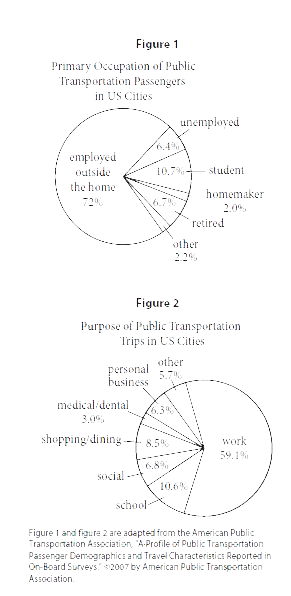
The central idea of the fourth paragraph (lines 35-57) is that
View SolutionThough there are 600 million cars on the planet, and counting, there are also seven billion people, which means that for the vast majority of us getting
around involves taking buses, ferryboats, commuter
line 5-trains, streetcars, and subways. In other words, traveling to work, school, or the market means being a straphanger: somebody who, by choice or necessity, relies on public transport, rather than a privately owned automobile.
line 10- Half the population of New York, Toronto, and London do not own cars. Public transport is how most of the people of Asia and Africa, the world’s most populous continents, travel. Every day, subway systems carry 155 million passengers, thirty-four
line 15- times the number carried by all the world’s airplanes, and the global public transport market is now valued at $428 billion annually. A century and a half after the invention of the internal combustion engine, private car ownership is still an anomaly.
line 20- And yet public transportation, in many minds, is the opposite of glamour—a squalid last resort for those with one too many impaired driving charges, too poor to afford insurance, or too decrepit to get behind the wheel of a car. In much of North
line 25- America, they are right: taking transit is a depressing experience. Anybody who has waited far too long on a street corner for the privilege of boarding a lurching, overcrowded bus, or wrestled luggage onto subways and shuttles to get to a big city airport,
line 30- knows that transit on this continent tends to be underfunded, ill-maintained, and ill-planned. Given the opportunity, who wouldn’t drive? Hopping in a car almost always gets you to your destination more quickly.
line 35- It doesn’t have to be like this. Done right, public transport can be faster, more comfortable, and cheaper than the private automobile. In Shanghai, German-made magnetic levitation trains skim over elevated tracks at 266 miles an hour, whisking people
line 40 - to the airport at a third of the speed of sound. In provincial French towns, electric-powered streetcars run silently on rubber tires, sliding through narrow streets along a single guide rail set into cobblestones. From Spain to Sweden, Wi-Fi equipped high-speed
line 45- trains seamlessly connect with highly ramified metro networks, allowing commuters to work on laptops as they prepare for same-day meetings in once distant capital cities. In Latin America, China, and India, working people board fast-loading buses that move
line 50 - like subway trains along dedicated busways, leaving the sedans and SUVs of the rich mired in dawn-to-dusk traffic jams. And some cities have transformed their streets into cycle-path freeways, making giant strides in public health and safety and ltbr line 55- the sheer livability of their neighborhoods—in the process turning the workaday bicycle into a viable form of mass transit. If you credit the demographers, this transit trend has legs. The “Millenials,” who reached adulthood
line 60 - around the turn of the century and now outnumber baby boomers, tend to favor cities over suburbs, and are far more willing than their parents to ride buses and subways. Part of the reason is their ease with iPads, MP3 players, Kindles, and smartphones: you
line 65- can get some serious texting done when you’re not driving, and earbuds offer effective insulation from all but the most extreme commuting annoyances. Even though there are more teenagers in the country than ever, only ten million have a driver’s license
line 70 - (versus twelve million a generation ago). Baby boomers may have been raised in Leave It to Beaver suburbs, but as they retire, a significant contingent is favoring older cities and compact towns where they have the option of walking and riding bikes. Seniors
line 75- too, are more likely to use transit, and by 2025, there will be 64 million Americans over the age of sixty-five. Already, dwellings in older neighborhoods in Washington, D.C., Atlanta, and Denver, especially those near light-rail or subway stations, are
line 80 - commanding enormous price premiums over suburban homes. The experience of European and Asian cities shows that if you make buses, subways, and trains convenient, comfortable, fast, and safe, a surprisingly large percentage of citizens will opt to
line 85- ride rather than drive.
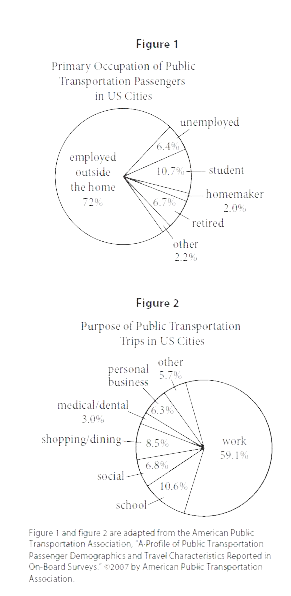
Which choice does the author explicitly cite as an advantage of automobile travel in North America
View Solution
Knowledge Check
Though there are 600 million cars on the planet, and counting, there are also seven billion people, which means that for the vast majority of us getting
around involves taking buses, ferryboats, commuter
line 5-trains, streetcars, and subways. In other words, traveling to work, school, or the market means being a straphanger: somebody who, by choice or necessity, relies on public transport, rather than a privately owned automobile.
line 10- Half the population of New York, Toronto, and London do not own cars. Public transport is how most of the people of Asia and Africa, the world’s most populous continents, travel. Every day, subway systems carry 155 million passengers, thirty-four
line 15- times the number carried by all the world’s airplanes, and the global public transport market is now valued at $428 billion annually. A century and a half after the invention of the internal combustion engine, private car ownership is still an anomaly.
line 20- And yet public transportation, in many minds, is the opposite of glamour—a squalid last resort for those with one too many impaired driving charges, too poor to afford insurance, or too decrepit to get behind the wheel of a car. In much of North
line 25- America, they are right: taking transit is a depressing experience. Anybody who has waited far too long on a street corner for the privilege of boarding a lurching, overcrowded bus, or wrestled luggage onto subways and shuttles to get to a big city airport,
line 30- knows that transit on this continent tends to be underfunded, ill-maintained, and ill-planned. Given the opportunity, who wouldn’t drive? Hopping in a car almost always gets you to your destination more quickly.
line 35- It doesn’t have to be like this. Done right, public transport can be faster, more comfortable, and cheaper than the private automobile. In Shanghai, German-made magnetic levitation trains skim over elevated tracks at 266 miles an hour, whisking people
line 40 - to the airport at a third of the speed of sound. In provincial French towns, electric-powered streetcars run silently on rubber tires, sliding through narrow streets along a single guide rail set into cobblestones. From Spain to Sweden, Wi-Fi equipped high-speed
line 45- trains seamlessly connect with highly ramified metro networks, allowing commuters to work on laptops as they prepare for same-day meetings in once distant capital cities. In Latin America, China, and India, working people board fast-loading buses that move
line 50 - like subway trains along dedicated busways, leaving the sedans and SUVs of the rich mired in dawn-to-dusk traffic jams. And some cities have transformed their streets into cycle-path freeways, making giant strides in public health and safety and ltbr line 55- the sheer livability of their neighborhoods—in the process turning the workaday bicycle into a viable form of mass transit. If you credit the demographers, this transit trend has legs. The “Millenials,” who reached adulthood
line 60 - around the turn of the century and now outnumber baby boomers, tend to favor cities over suburbs, and are far more willing than their parents to ride buses and subways. Part of the reason is their ease with iPads, MP3 players, Kindles, and smartphones: you
line 65- can get some serious texting done when you’re not driving, and earbuds offer effective insulation from all but the most extreme commuting annoyances. Even though there are more teenagers in the country than ever, only ten million have a driver’s license
line 70 - (versus twelve million a generation ago). Baby boomers may have been raised in Leave It to Beaver suburbs, but as they retire, a significant contingent is favoring older cities and compact towns where they have the option of walking and riding bikes. Seniors
line 75- too, are more likely to use transit, and by 2025, there will be 64 million Americans over the age of sixty-five. Already, dwellings in older neighborhoods in Washington, D.C., Atlanta, and Denver, especially those near light-rail or subway stations, are
line 80 - commanding enormous price premiums over suburban homes. The experience of European and Asian cities shows that if you make buses, subways, and trains convenient, comfortable, fast, and safe, a surprisingly large percentage of citizens will opt to
line 85- ride rather than drive.
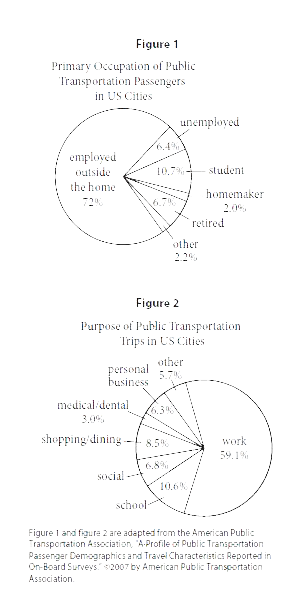
Which choice provides the best evidence for the answer to the previous question?ALine 35 (“It... this”)BLines 35-37 (“Done... automobile”)CLines 37-40 (“In... sound”)DLines 44-48 (“From... cities”)Though there are 600 million cars on the planet, and counting, there are also seven billion people, which means that for the vast majority of us getting
around involves taking buses, ferryboats, commuter
line 5-trains, streetcars, and subways. In other words, traveling to work, school, or the market means being a straphanger: somebody who, by choice or necessity, relies on public transport, rather than a privately owned automobile.
line 10- Half the population of New York, Toronto, and London do not own cars. Public transport is how most of the people of Asia and Africa, the world’s most populous continents, travel. Every day, subway systems carry 155 million passengers, thirty-four
line 15- times the number carried by all the world’s airplanes, and the global public transport market is now valued at $428 billion annually. A century and a half after the invention of the internal combustion engine, private car ownership is still an anomaly.
line 20- And yet public transportation, in many minds, is the opposite of glamour—a squalid last resort for those with one too many impaired driving charges, too poor to afford insurance, or too decrepit to get behind the wheel of a car. In much of North
line 25- America, they are right: taking transit is a depressing experience. Anybody who has waited far too long on a street corner for the privilege of boarding a lurching, overcrowded bus, or wrestled luggage onto subways and shuttles to get to a big city airport,
line 30- knows that transit on this continent tends to be underfunded, ill-maintained, and ill-planned. Given the opportunity, who wouldn’t drive? Hopping in a car almost always gets you to your destination more quickly.
line 35- It doesn’t have to be like this. Done right, public transport can be faster, more comfortable, and cheaper than the private automobile. In Shanghai, German-made magnetic levitation trains skim over elevated tracks at 266 miles an hour, whisking people
line 40 - to the airport at a third of the speed of sound. In provincial French towns, electric-powered streetcars run silently on rubber tires, sliding through narrow streets along a single guide rail set into cobblestones. From Spain to Sweden, Wi-Fi equipped high-speed
line 45- trains seamlessly connect with highly ramified metro networks, allowing commuters to work on laptops as they prepare for same-day meetings in once distant capital cities. In Latin America, China, and India, working people board fast-loading buses that move
line 50 - like subway trains along dedicated busways, leaving the sedans and SUVs of the rich mired in dawn-to-dusk traffic jams. And some cities have transformed their streets into cycle-path freeways, making giant strides in public health and safety and ltbr line 55- the sheer livability of their neighborhoods—in the process turning the workaday bicycle into a viable form of mass transit. If you credit the demographers, this transit trend has legs. The “Millenials,” who reached adulthood
line 60 - around the turn of the century and now outnumber baby boomers, tend to favor cities over suburbs, and are far more willing than their parents to ride buses and subways. Part of the reason is their ease with iPads, MP3 players, Kindles, and smartphones: you
line 65- can get some serious texting done when you’re not driving, and earbuds offer effective insulation from all but the most extreme commuting annoyances. Even though there are more teenagers in the country than ever, only ten million have a driver’s license
line 70 - (versus twelve million a generation ago). Baby boomers may have been raised in Leave It to Beaver suburbs, but as they retire, a significant contingent is favoring older cities and compact towns where they have the option of walking and riding bikes. Seniors
line 75- too, are more likely to use transit, and by 2025, there will be 64 million Americans over the age of sixty-five. Already, dwellings in older neighborhoods in Washington, D.C., Atlanta, and Denver, especially those near light-rail or subway stations, are
line 80 - commanding enormous price premiums over suburban homes. The experience of European and Asian cities shows that if you make buses, subways, and trains convenient, comfortable, fast, and safe, a surprisingly large percentage of citizens will opt to
line 85- ride rather than drive.
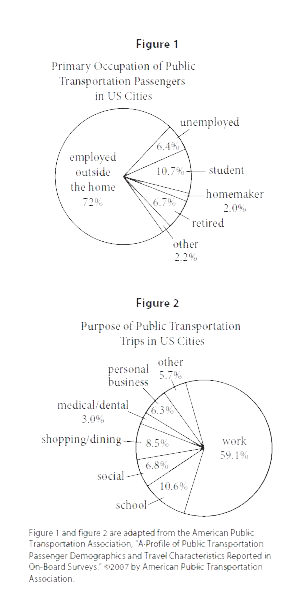
As used in line 61, “favor” most nearly meansAindulgeBprefer.Cresemble.DserveThough there are 600 million cars on the planet, and counting, there are also seven billion people, which means that for the vast majority of us getting
around involves taking buses, ferryboats, commuter
line 5-trains, streetcars, and subways. In other words, traveling to work, school, or the market means being a straphanger: somebody who, by choice or necessity, relies on public transport, rather than a privately owned automobile.
line 10- Half the population of New York, Toronto, and London do not own cars. Public transport is how most of the people of Asia and Africa, the world’s most populous continents, travel. Every day, subway systems carry 155 million passengers, thirty-four
line 15- times the number carried by all the world’s airplanes, and the global public transport market is now valued at $428 billion annually. A century and a half after the invention of the internal combustion engine, private car ownership is still an anomaly.
line 20- And yet public transportation, in many minds, is the opposite of glamour—a squalid last resort for those with one too many impaired driving charges, too poor to afford insurance, or too decrepit to get behind the wheel of a car. In much of North
line 25- America, they are right: taking transit is a depressing experience. Anybody who has waited far too long on a street corner for the privilege of boarding a lurching, overcrowded bus, or wrestled luggage onto subways and shuttles to get to a big city airport,
line 30- knows that transit on this continent tends to be underfunded, ill-maintained, and ill-planned. Given the opportunity, who wouldn’t drive? Hopping in a car almost always gets you to your destination more quickly.
line 35- It doesn’t have to be like this. Done right, public transport can be faster, more comfortable, and cheaper than the private automobile. In Shanghai, German-made magnetic levitation trains skim over elevated tracks at 266 miles an hour, whisking people
line 40 - to the airport at a third of the speed of sound. In provincial French towns, electric-powered streetcars run silently on rubber tires, sliding through narrow streets along a single guide rail set into cobblestones. From Spain to Sweden, Wi-Fi equipped high-speed
line 45- trains seamlessly connect with highly ramified metro networks, allowing commuters to work on laptops as they prepare for same-day meetings in once distant capital cities. In Latin America, China, and India, working people board fast-loading buses that move
line 50 - like subway trains along dedicated busways, leaving the sedans and SUVs of the rich mired in dawn-to-dusk traffic jams. And some cities have transformed their streets into cycle-path freeways, making giant strides in public health and safety and ltbr line 55- the sheer livability of their neighborhoods—in the process turning the workaday bicycle into a viable form of mass transit. If you credit the demographers, this transit trend has legs. The “Millenials,” who reached adulthood
line 60 - around the turn of the century and now outnumber baby boomers, tend to favor cities over suburbs, and are far more willing than their parents to ride buses and subways. Part of the reason is their ease with iPads, MP3 players, Kindles, and smartphones: you
line 65- can get some serious texting done when you’re not driving, and earbuds offer effective insulation from all but the most extreme commuting annoyances. Even though there are more teenagers in the country than ever, only ten million have a driver’s license
line 70 - (versus twelve million a generation ago). Baby boomers may have been raised in Leave It to Beaver suburbs, but as they retire, a significant contingent is favoring older cities and compact towns where they have the option of walking and riding bikes. Seniors
line 75- too, are more likely to use transit, and by 2025, there will be 64 million Americans over the age of sixty-five. Already, dwellings in older neighborhoods in Washington, D.C., Atlanta, and Denver, especially those near light-rail or subway stations, are
line 80 - commanding enormous price premiums over suburban homes. The experience of European and Asian cities shows that if you make buses, subways, and trains convenient, comfortable, fast, and safe, a surprisingly large percentage of citizens will opt to
line 85- ride rather than drive.

Taken together, the two figures suggest that most people who use public transportationAare employed outside the home and take public transportation to workBare employed outside the home but take public transportation primarily in order to run errands.Cuse public transportation during the week but use their private cars on weekends.Duse public transportation only until they are able to afford to buy a car.
Though there are 600 million cars on the planet, and counting, there are also seven billion people, which means that for the vast majority of us getting
around involves taking buses, ferryboats, commuter
line 5-trains, streetcars, and subways. In other words, traveling to work, school, or the market means being a straphanger: somebody who, by choice or necessity, relies on public transport, rather than a privately owned automobile.
line 10- Half the population of New York, Toronto, and London do not own cars. Public transport is how most of the people of Asia and Africa, the world’s most populous continents, travel. Every day, subway systems carry 155 million passengers, thirty-four
line 15- times the number carried by all the world’s airplanes, and the global public transport market is now valued at $428 billion annually. A century and a half after the invention of the internal combustion engine, private car ownership is still an anomaly.
line 20- And yet public transportation, in many minds, is the opposite of glamour—a squalid last resort for those with one too many impaired driving charges, too poor to afford insurance, or too decrepit to get behind the wheel of a car. In much of North
line 25- America, they are right: taking transit is a depressing experience. Anybody who has waited far too long on a street corner for the privilege of boarding a lurching, overcrowded bus, or wrestled luggage onto subways and shuttles to get to a big city airport,
line 30- knows that transit on this continent tends to be underfunded, ill-maintained, and ill-planned. Given the opportunity, who wouldn’t drive? Hopping in a car almost always gets you to your destination more quickly.
line 35- It doesn’t have to be like this. Done right, public transport can be faster, more comfortable, and cheaper than the private automobile. In Shanghai, German-made magnetic levitation trains skim over elevated tracks at 266 miles an hour, whisking people
line 40 - to the airport at a third of the speed of sound. In provincial French towns, electric-powered streetcars run silently on rubber tires, sliding through narrow streets along a single guide rail set into cobblestones. From Spain to Sweden, Wi-Fi equipped high-speed
line 45- trains seamlessly connect with highly ramified metro networks, allowing commuters to work on laptops as they prepare for same-day meetings in once distant capital cities. In Latin America, China, and India, working people board fast-loading buses that move
line 50 - like subway trains along dedicated busways, leaving the sedans and SUVs of the rich mired in dawn-to-dusk traffic jams. And some cities have transformed their streets into cycle-path freeways, making giant strides in public health and safety and ltbr line 55- the sheer livability of their neighborhoods—in the process turning the workaday bicycle into a viable form of mass transit. If you credit the demographers, this transit trend has legs. The “Millenials,” who reached adulthood
line 60 - around the turn of the century and now outnumber baby boomers, tend to favor cities over suburbs, and are far more willing than their parents to ride buses and subways. Part of the reason is their ease with iPads, MP3 players, Kindles, and smartphones: you
line 65- can get some serious texting done when you’re not driving, and earbuds offer effective insulation from all but the most extreme commuting annoyances. Even though there are more teenagers in the country than ever, only ten million have a driver’s license
line 70 - (versus twelve million a generation ago). Baby boomers may have been raised in Leave It to Beaver suburbs, but as they retire, a significant contingent is favoring older cities and compact towns where they have the option of walking and riding bikes. Seniors
line 75- too, are more likely to use transit, and by 2025, there will be 64 million Americans over the age of sixty-five. Already, dwellings in older neighborhoods in Washington, D.C., Atlanta, and Denver, especially those near light-rail or subway stations, are
line 80 - commanding enormous price premiums over suburban homes. The experience of European and Asian cities shows that if you make buses, subways, and trains convenient, comfortable, fast, and safe, a surprisingly large percentage of citizens will opt to
line 85- ride rather than drive.
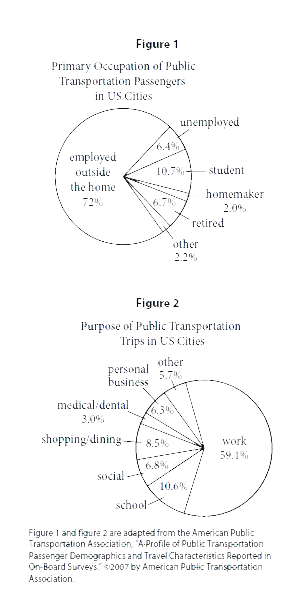
As used in line 58, “credit” most nearly means
View SolutionThough there are 600 million cars on the planet, and counting, there are also seven billion people, which means that for the vast majority of us getting
around involves taking buses, ferryboats, commuter
line 5-trains, streetcars, and subways. In other words, traveling to work, school, or the market means being a straphanger: somebody who, by choice or necessity, relies on public transport, rather than a privately owned automobile.
line 10- Half the population of New York, Toronto, and London do not own cars. Public transport is how most of the people of Asia and Africa, the world’s most populous continents, travel. Every day, subway systems carry 155 million passengers, thirty-four
line 15- times the number carried by all the world’s airplanes, and the global public transport market is now valued at $428 billion annually. A century and a half after the invention of the internal combustion engine, private car ownership is still an anomaly.
line 20- And yet public transportation, in many minds, is the opposite of glamour—a squalid last resort for those with one too many impaired driving charges, too poor to afford insurance, or too decrepit to get behind the wheel of a car. In much of North
line 25- America, they are right: taking transit is a depressing experience. Anybody who has waited far too long on a street corner for the privilege of boarding a lurching, overcrowded bus, or wrestled luggage onto subways and shuttles to get to a big city airport,
line 30- knows that transit on this continent tends to be underfunded, ill-maintained, and ill-planned. Given the opportunity, who wouldn’t drive? Hopping in a car almost always gets you to your destination more quickly.
line 35- It doesn’t have to be like this. Done right, public transport can be faster, more comfortable, and cheaper than the private automobile. In Shanghai, German-made magnetic levitation trains skim over elevated tracks at 266 miles an hour, whisking people
line 40 - to the airport at a third of the speed of sound. In provincial French towns, electric-powered streetcars run silently on rubber tires, sliding through narrow streets along a single guide rail set into cobblestones. From Spain to Sweden, Wi-Fi equipped high-speed
line 45- trains seamlessly connect with highly ramified metro networks, allowing commuters to work on laptops as they prepare for same-day meetings in once distant capital cities. In Latin America, China, and India, working people board fast-loading buses that move
line 50 - like subway trains along dedicated busways, leaving the sedans and SUVs of the rich mired in dawn-to-dusk traffic jams. And some cities have transformed their streets into cycle-path freeways, making giant strides in public health and safety and ltbr line 55- the sheer livability of their neighborhoods—in the process turning the workaday bicycle into a viable form of mass transit. If you credit the demographers, this transit trend has legs. The “Millenials,” who reached adulthood
line 60 - around the turn of the century and now outnumber baby boomers, tend to favor cities over suburbs, and are far more willing than their parents to ride buses and subways. Part of the reason is their ease with iPads, MP3 players, Kindles, and smartphones: you
line 65- can get some serious texting done when you’re not driving, and earbuds offer effective insulation from all but the most extreme commuting annoyances. Even though there are more teenagers in the country than ever, only ten million have a driver’s license
line 70 - (versus twelve million a generation ago). Baby boomers may have been raised in Leave It to Beaver suburbs, but as they retire, a significant contingent is favoring older cities and compact towns where they have the option of walking and riding bikes. Seniors
line 75- too, are more likely to use transit, and by 2025, there will be 64 million Americans over the age of sixty-five. Already, dwellings in older neighborhoods in Washington, D.C., Atlanta, and Denver, especially those near light-rail or subway stations, are
line 80 - commanding enormous price premiums over suburban homes. The experience of European and Asian cities shows that if you make buses, subways, and trains convenient, comfortable, fast, and safe, a surprisingly large percentage of citizens will opt to
line 85- ride rather than drive.
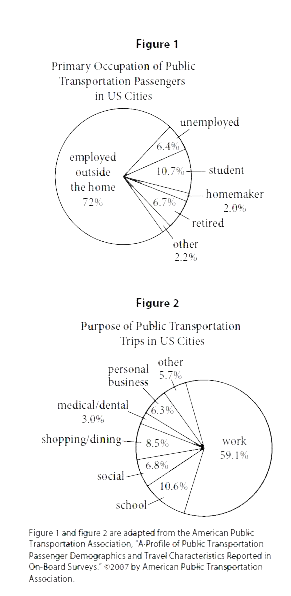
Which choice provides the best evidence for the answer to the previous question?
View SolutionThough there are 600 million cars on the planet, and counting, there are also seven billion people, which means that for the vast majority of us getting
around involves taking buses, ferryboats, commuter
line 5-trains, streetcars, and subways. In other words, traveling to work, school, or the market means being a straphanger: somebody who, by choice or necessity, relies on public transport, rather than a privately owned automobile.
line 10- Half the population of New York, Toronto, and London do not own cars. Public transport is how most of the people of Asia and Africa, the world’s most populous continents, travel. Every day, subway systems carry 155 million passengers, thirty-four
line 15- times the number carried by all the world’s airplanes, and the global public transport market is now valued at $428 billion annually. A century and a half after the invention of the internal combustion engine, private car ownership is still an anomaly.
line 20- And yet public transportation, in many minds, is the opposite of glamour—a squalid last resort for those with one too many impaired driving charges, too poor to afford insurance, or too decrepit to get behind the wheel of a car. In much of North
line 25- America, they are right: taking transit is a depressing experience. Anybody who has waited far too long on a street corner for the privilege of boarding a lurching, overcrowded bus, or wrestled luggage onto subways and shuttles to get to a big city airport,
line 30- knows that transit on this continent tends to be underfunded, ill-maintained, and ill-planned. Given the opportunity, who wouldn’t drive? Hopping in a car almost always gets you to your destination more quickly.
line 35- It doesn’t have to be like this. Done right, public transport can be faster, more comfortable, and cheaper than the private automobile. In Shanghai, German-made magnetic levitation trains skim over elevated tracks at 266 miles an hour, whisking people
line 40 - to the airport at a third of the speed of sound. In provincial French towns, electric-powered streetcars run silently on rubber tires, sliding through narrow streets along a single guide rail set into cobblestones. From Spain to Sweden, Wi-Fi equipped high-speed
line 45- trains seamlessly connect with highly ramified metro networks, allowing commuters to work on laptops as they prepare for same-day meetings in once distant capital cities. In Latin America, China, and India, working people board fast-loading buses that move
line 50 - like subway trains along dedicated busways, leaving the sedans and SUVs of the rich mired in dawn-to-dusk traffic jams. And some cities have transformed their streets into cycle-path freeways, making giant strides in public health and safety and ltbr line 55- the sheer livability of their neighborhoods—in the process turning the workaday bicycle into a viable form of mass transit. If you credit the demographers, this transit trend has legs. The “Millenials,” who reached adulthood
line 60 - around the turn of the century and now outnumber baby boomers, tend to favor cities over suburbs, and are far more willing than their parents to ride buses and subways. Part of the reason is their ease with iPads, MP3 players, Kindles, and smartphones: you
line 65- can get some serious texting done when you’re not driving, and earbuds offer effective insulation from all but the most extreme commuting annoyances. Even though there are more teenagers in the country than ever, only ten million have a driver’s license
line 70 - (versus twelve million a generation ago). Baby boomers may have been raised in Leave It to Beaver suburbs, but as they retire, a significant contingent is favoring older cities and compact towns where they have the option of walking and riding bikes. Seniors
line 75- too, are more likely to use transit, and by 2025, there will be 64 million Americans over the age of sixty-five. Already, dwellings in older neighborhoods in Washington, D.C., Atlanta, and Denver, especially those near light-rail or subway stations, are
line 80 - commanding enormous price premiums over suburban homes. The experience of European and Asian cities shows that if you make buses, subways, and trains convenient, comfortable, fast, and safe, a surprisingly large percentage of citizens will opt to
line 85- ride rather than drive.
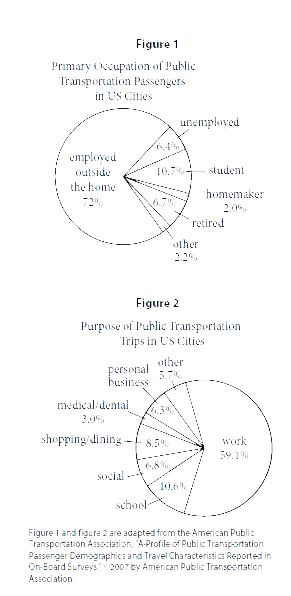
Which choice best supports the conclusion that public transportation is compatible with the use of personal electronic devices?
View SolutionThough there are 600 million cars on the planet, and counting, there are also seven billion people, which means that for the vast majority of us getting
around involves taking buses, ferryboats, commuter
line 5-trains, streetcars, and subways. In other words, traveling to work, school, or the market means being a straphanger: somebody who, by choice or necessity, relies on public transport, rather than a privately owned automobile.
line 10- Half the population of New York, Toronto, and London do not own cars. Public transport is how most of the people of Asia and Africa, the world’s most populous continents, travel. Every day, subway systems carry 155 million passengers, thirty-four
line 15- times the number carried by all the world’s airplanes, and the global public transport market is now valued at $428 billion annually. A century and a half after the invention of the internal combustion engine, private car ownership is still an anomaly.
line 20- And yet public transportation, in many minds, is the opposite of glamour—a squalid last resort for those with one too many impaired driving charges, too poor to afford insurance, or too decrepit to get behind the wheel of a car. In much of North
line 25- America, they are right: taking transit is a depressing experience. Anybody who has waited far too long on a street corner for the privilege of boarding a lurching, overcrowded bus, or wrestled luggage onto subways and shuttles to get to a big city airport,
line 30- knows that transit on this continent tends to be underfunded, ill-maintained, and ill-planned. Given the opportunity, who wouldn’t drive? Hopping in a car almost always gets you to your destination more quickly.
line 35- It doesn’t have to be like this. Done right, public transport can be faster, more comfortable, and cheaper than the private automobile. In Shanghai, German-made magnetic levitation trains skim over elevated tracks at 266 miles an hour, whisking people
line 40 - to the airport at a third of the speed of sound. In provincial French towns, electric-powered streetcars run silently on rubber tires, sliding through narrow streets along a single guide rail set into cobblestones. From Spain to Sweden, Wi-Fi equipped high-speed
line 45- trains seamlessly connect with highly ramified metro networks, allowing commuters to work on laptops as they prepare for same-day meetings in once distant capital cities. In Latin America, China, and India, working people board fast-loading buses that move
line 50 - like subway trains along dedicated busways, leaving the sedans and SUVs of the rich mired in dawn-to-dusk traffic jams. And some cities have transformed their streets into cycle-path freeways, making giant strides in public health and safety and ltbr line 55- the sheer livability of their neighborhoods—in the process turning the workaday bicycle into a viable form of mass transit. If you credit the demographers, this transit trend has legs. The “Millenials,” who reached adulthood
line 60 - around the turn of the century and now outnumber baby boomers, tend to favor cities over suburbs, and are far more willing than their parents to ride buses and subways. Part of the reason is their ease with iPads, MP3 players, Kindles, and smartphones: you
line 65- can get some serious texting done when you’re not driving, and earbuds offer effective insulation from all but the most extreme commuting annoyances. Even though there are more teenagers in the country than ever, only ten million have a driver’s license
line 70 - (versus twelve million a generation ago). Baby boomers may have been raised in Leave It to Beaver suburbs, but as they retire, a significant contingent is favoring older cities and compact towns where they have the option of walking and riding bikes. Seniors
line 75- too, are more likely to use transit, and by 2025, there will be 64 million Americans over the age of sixty-five. Already, dwellings in older neighborhoods in Washington, D.C., Atlanta, and Denver, especially those near light-rail or subway stations, are
line 80 - commanding enormous price premiums over suburban homes. The experience of European and Asian cities shows that if you make buses, subways, and trains convenient, comfortable, fast, and safe, a surprisingly large percentage of citizens will opt to
line 85- ride rather than drive.
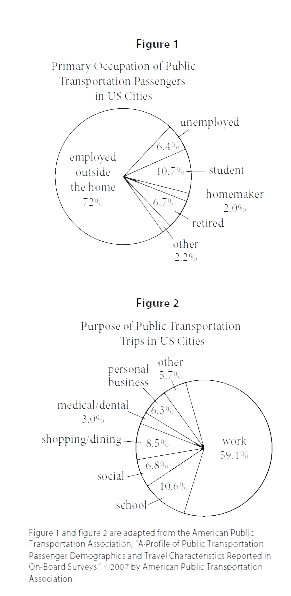
What function does the third paragraph (lines 20-34) serve in the passage as a whole?
View SolutionThough there are 600 million cars on the planet, and counting, there are also seven billion people, which means that for the vast majority of us getting
around involves taking buses, ferryboats, commuter
line 5-trains, streetcars, and subways. In other words, traveling to work, school, or the market means being a straphanger: somebody who, by choice or necessity, relies on public transport, rather than a privately owned automobile.
line 10- Half the population of New York, Toronto, and London do not own cars. Public transport is how most of the people of Asia and Africa, the world’s most populous continents, travel. Every day, subway systems carry 155 million passengers, thirty-four
line 15- times the number carried by all the world’s airplanes, and the global public transport market is now valued at $428 billion annually. A century and a half after the invention of the internal combustion engine, private car ownership is still an anomaly.
line 20- And yet public transportation, in many minds, is the opposite of glamour—a squalid last resort for those with one too many impaired driving charges, too poor to afford insurance, or too decrepit to get behind the wheel of a car. In much of North
line 25- America, they are right: taking transit is a depressing experience. Anybody who has waited far too long on a street corner for the privilege of boarding a lurching, overcrowded bus, or wrestled luggage onto subways and shuttles to get to a big city airport,
line 30- knows that transit on this continent tends to be underfunded, ill-maintained, and ill-planned. Given the opportunity, who wouldn’t drive? Hopping in a car almost always gets you to your destination more quickly.
line 35- It doesn’t have to be like this. Done right, public transport can be faster, more comfortable, and cheaper than the private automobile. In Shanghai, German-made magnetic levitation trains skim over elevated tracks at 266 miles an hour, whisking people
line 40 - to the airport at a third of the speed of sound. In provincial French towns, electric-powered streetcars run silently on rubber tires, sliding through narrow streets along a single guide rail set into cobblestones. From Spain to Sweden, Wi-Fi equipped high-speed
line 45- trains seamlessly connect with highly ramified metro networks, allowing commuters to work on laptops as they prepare for same-day meetings in once distant capital cities. In Latin America, China, and India, working people board fast-loading buses that move
line 50 - like subway trains along dedicated busways, leaving the sedans and SUVs of the rich mired in dawn-to-dusk traffic jams. And some cities have transformed their streets into cycle-path freeways, making giant strides in public health and safety and ltbr line 55- the sheer livability of their neighborhoods—in the process turning the workaday bicycle into a viable form of mass transit. If you credit the demographers, this transit trend has legs. The “Millenials,” who reached adulthood
line 60 - around the turn of the century and now outnumber baby boomers, tend to favor cities over suburbs, and are far more willing than their parents to ride buses and subways. Part of the reason is their ease with iPads, MP3 players, Kindles, and smartphones: you
line 65- can get some serious texting done when you’re not driving, and earbuds offer effective insulation from all but the most extreme commuting annoyances. Even though there are more teenagers in the country than ever, only ten million have a driver’s license
line 70 - (versus twelve million a generation ago). Baby boomers may have been raised in Leave It to Beaver suburbs, but as they retire, a significant contingent is favoring older cities and compact towns where they have the option of walking and riding bikes. Seniors
line 75- too, are more likely to use transit, and by 2025, there will be 64 million Americans over the age of sixty-five. Already, dwellings in older neighborhoods in Washington, D.C., Atlanta, and Denver, especially those near light-rail or subway stations, are
line 80 - commanding enormous price premiums over suburban homes. The experience of European and Asian cities shows that if you make buses, subways, and trains convenient, comfortable, fast, and safe, a surprisingly large percentage of citizens will opt to
line 85- ride rather than drive.
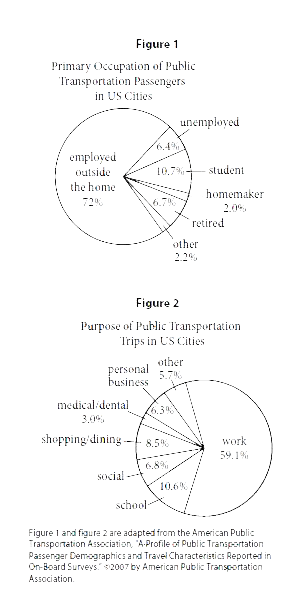
Which choice is supported by the data in the first figure?
View Solution
